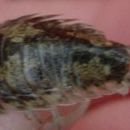Comprehensive Description
(
Inglês
)
fornecido por Invertebrates of the Salish Sea
The bodies of these isopods are usually robust and approximately 35 mm in length, however I found that around Swirl Rocks these isopods greatly vary in size. The eyes are separated by a distance equal to twice the greatest diameter of an eye. They have short uropods, and a basal segment as long as broad. Their uropods are terminal and close to the midline.
- licença
- cc-by-nc-sa
- direitos autorais
- Rosario Beach Marine Laboratory
Look Alikes
(
Inglês
)
fornecido por Invertebrates of the Salish Sea
How to Distinguish from Similar Species: They may be confused with their relative, L. occidentalis in central California because of geographic overlap. However, where overlap occurs the two species are generally ecologically segregated in that the L. pallasii prefers sea cliffs and the L. occidentalis prefers rocky beaches. Essentially terrestrial, they prefer to live near the high tide line.
- licença
- cc-by-nc-sa
- direitos autorais
- Rosario Beach Marine Laboratory
Comprehensive Description
(
Inglês
)
fornecido por Invertebrates of the Salish Sea
Biology/Natural History: A researcher, Wilson, found that the osmoregulatory responses might differ according to their behavior and ecology. The slower moving Ligia pallasii that live permanently in cool, moist habitats are characterized by fluctuating hyposaline conditions, whereas their faster moving relative, L. occidentalis alternates between dry and wet conditions so it can replace water previously lost by evaporation. This species of isopods are aerobic and breathe using pleopods, which need to be moist in order to function properly. To keep this moistness, the isopod must be immersed or dip the tail in water so that the uropods can serve as capillary siphons. Ligia pallasii feed on dead plants and animals, and the algal film from upper intertidal rocks. They are primarily fed upon by birds and crabs. The life span of these isopods is about 1.5-2 years with the breeding period in the spring and early summer months. Mothers brood their young, which do not have a planktonic larval stage. Given this life cycle, the exchange of genes among populations up and down the coast may be limited. Molecular genetic studies show that this species is most diverse genetically in the southern part of its range and that much of the northern range may have only a few closely related haplotypes.
- licença
- cc-by-nc-sa
- direitos autorais
- Rosario Beach Marine Laboratory
Ligia pallasii
(
Inglês
)
fornecido por wikipedia EN
Ligia pallasii, the rock louse, is a species of rock slater in the family Ligiidae. It is found in North America.[1][2][3]
References

- licença
- cc-by-sa-3.0
- direitos autorais
- Wikipedia authors and editors
Ligia pallasii: Brief Summary
(
Inglês
)
fornecido por wikipedia EN
Ligia pallasii, the rock louse, is a species of rock slater in the family Ligiidae. It is found in North America.
- licença
- cc-by-sa-3.0
- direitos autorais
- Wikipedia authors and editors
Ligia pallasii
(
Neerlandês; Flamengo
)
fornecido por wikipedia NL
Ligia pallasii is een pissebed uit de familie Ligiidae. De wetenschappelijke naam van de soort is voor het eerst geldig gepubliceerd in 1833 door Brandt.[1]
Bronnen, noten en/of referenties -
↑ Schotte, M. (2010). Ligia pallasii. In: Schotte, M., Boyko, C.B, Bruce, N.L., Poore, G.C.B., Taiti, S., Wilson, G.D.F. (Eds) (2010). World Marine, Freshwater and Terrestrial Isopod Crustaceans database. Gebaseerd op informatie uit het World Register of Marine Species, te vinden op http://www.marinespecies.org/aphia.php?p=taxdetails&id=257558
Geplaatst op:
15-12-2011
Dit artikel is een beginnetje over biologie. U wordt uitgenodigd om op bewerken te klikken om uw kennis aan dit artikel toe te voegen.

- licença
- cc-by-sa-3.0
- direitos autorais
- Wikipedia-auteurs en -editors
Ligia pallasii
(
Vietnamita
)
fornecido por wikipedia VI
Ligia pallasii là một loài chân đều trong họ Ligiidae. Loài này được Brandt miêu tả khoa học năm 1833.[1]
Chú thích
-
^ Schotte, M. (2010). Ligia pallasii. In: Schotte, M., Boyko, C.B, Bruce, N.L., Poore, G.C.B., Taiti, S., Wilson, G.D.F. (Eds) (2010). World Marine, Freshwater and Terrestrial Isopod Crustaceans database. Gebaseerd op informatie uit het Cơ sở dữ liệu sinh vật biển, te vinden op http://www.marinespecies.org/aphia.php?p=taxdetails&id=257558
Tham khảo
- licença
- cc-by-sa-3.0
- direitos autorais
- Wikipedia tác giả và biên tập viên
Ligia pallasii: Brief Summary
(
Vietnamita
)
fornecido por wikipedia VI
Ligia pallasii là một loài chân đều trong họ Ligiidae. Loài này được Brandt miêu tả khoa học năm 1833.
- licença
- cc-by-sa-3.0
- direitos autorais
- Wikipedia tác giả và biên tập viên

